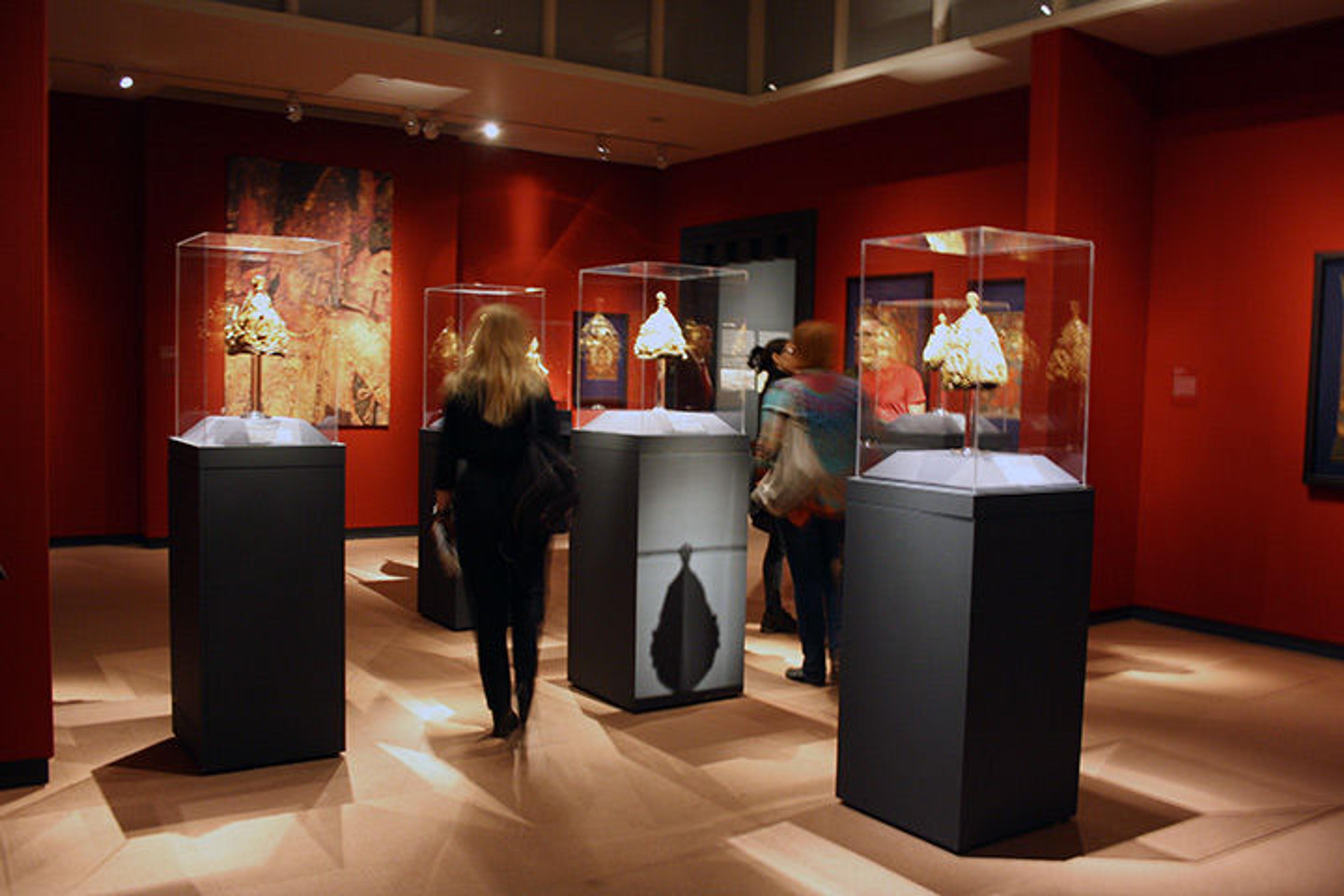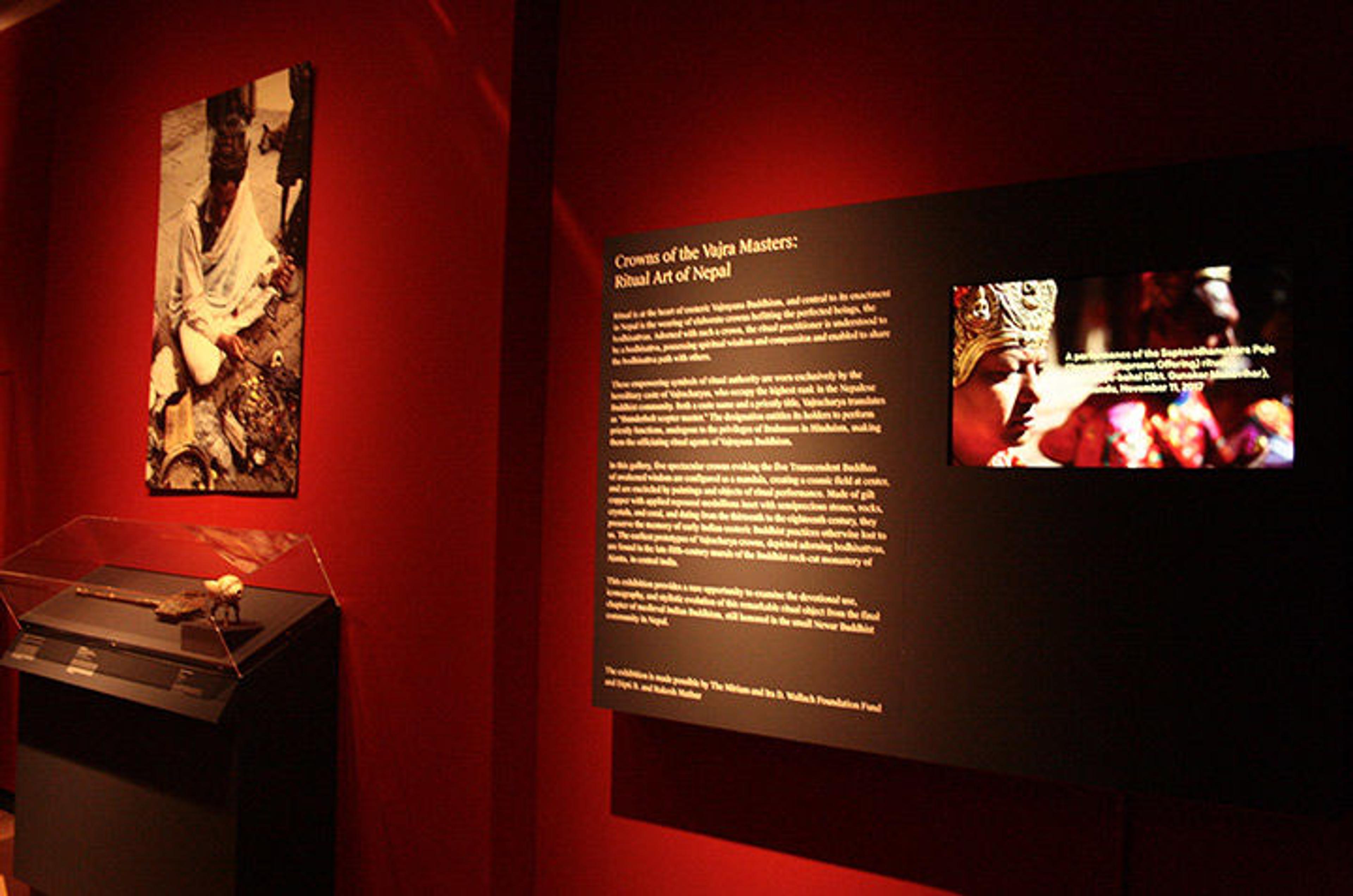«In Nepal, certain crowns possess an esoteric power when held in the hands or worn on the head of initiated tantric priests. Such objects are potent symbols of the esoteric Buddhism of Nepal and enshrine the status of tantric specialists in Nepalese Buddhist society. The act of wearing such a crown plays an essential role in the construction and visual manifestation of power.»
Five ritual crowns are the main focus of Crowns of the Vajra Masters: Ritual Art of Nepal, an exhibition on view at The Met Fifth Avenue through December 16, 2018.

Work in progress for the installation of Crowns of the Vajra Masters: Ritual Art of Nepal in gallery 251
Curated by John Guy, Florence and Herbert Irving Curator of the Arts of South and Southeast Asia, the exhibition draws from the holdings of two curatorial departments, the Department of Asian Art and the Department of Arms and Armor. As a fellow in Asian Art, I had the opportunity to assist at the installation of the exhibition in December 2017 and to appreciate how curators, conservators, and exhibition designers worked collaboratively to put it together.
The Crowns

Vajracharya priest's crown, ca. 15th–16th century. Nepal. Copper, gold, turquoise, semi-precious stones, silver foil. 13 1/2 x 8 5/8 x 9 1/8 in. Nepal. The Metropolitan Museum of Art, New York, Rogers Fund, 1948 (48.128)
The main focus of the exhibition is a group of five ritual crowns covering a five-hundred-year period from the thirteenth to the eighteenth century. The crowns are a splendid example of the virtuosic skills of Newar craftsmen working in a repoussé technique that has thrived in the Kathmandu Valley since at least the seventh century. Each crown, which can weigh up to five pounds or more, is made out of sheets of embossed copper that have been hammered and joined together. The surface is fire-gilt, and the bands and decorative plaques are encrusted with semi-precious stones, such as crystals and turquoise.
Such refined metalwork was praised more than a thousand years ago by the Chinese envoy Wang Hsuan-t'se, who travelled across the valley between A.D. 643 and 661:
Their king Nalingtipo adorns himself with true pearls, rock crystal, mother-of-pearl, coral, and amber; he has in the ears rings of gold and pendant of jade, and a breloc belt ornament with the figure of a Buddha. . . . In the middle of the palace there is a tower of seven stories roofed with copper tiles. Its balustrades, grilles, columns, beams, and everything therein, are set with fine and even precious stones.
The Exhibition

Installation view of Crowns of the Vajra Masters: Ritual Art of Nepal
As we step into the gallery, our eyes are caught by the display of the artworks at the center of the room. The five crowns are arranged in a circular diagram that mimics a mandala, so that the visitor can walk through the installation and enter the equivalent of a cosmic field.
The arrangement of the installation establishes a fascinating visual parallel with the cosmological symbolism embedded in the structure of the crowns, which can be seen as three-dimensional mandalas.

Vajracharya priest's crown, ca. 13th century. Nepal. Copper, gold, crystal, turquoise, 14 x 8 1/2 x 9 in. Nepal. The Metropolitan Museum of Art, New York, Gift of Bashford Dean, 1906 (06.191)
The earliest crown of the five, which dates to the thirteenth century, offers a clear example. The components of this crown can be identified with the core iconographic elements of a mandala.
The helmet-like triple mound represents Mount Meru, which is the fulcrum of the universe. Plaques with four of the five transcendent Buddhas are evenly distributed on the first level of the mound. Each Buddha wears a crown and jewels, and sits cross-legged on a lotus pedestal atop a kirtimukha. On the upper levels of the mound are plaques with various Buddhist symbols, as well as the image of a female goddess holding a windblown sash. The fifth transcendent Buddha is symbolically represented by a half-vajra placed at the top of the crown.

Left: Vajracharya priest's crown (detail), ca. 15th–16th century. Nepal. Copper, gold, turquoise, semi-precious stones, silver foil, 13 1/2 x 8 5/8 x 9 1/8 in. The Metropolitan Museum of Art, New York, Rogers Fund, 1948 (48.128). Right: A half-vajra at the top of a silver incense burner in the main shrine at Kva Baha, Lalitpur, Nepal
In tantric Buddhist practice, the vajra is a potent instrument with multifaceted meaning, symbolizing the adamantine state of existence of a Buddhist practitioner who has reached full enlightenment. The vajra is the archetypal symbol of tantric Buddhism. Indeed, numerous other tantric ritual objects are also adorned with a half-vajra, such as the lid of the incense burner above.
The Ritual Context
The walls of the gallery present a visual narrative about the ritual agency of the crowns, which are believed to have the power to mold the high status of a Vajracharya priest. The artworks displayed stress the antiquity of the tradition and help visitors understand how these objects were used in a liturgical context.

Left: Mandala of the sun god Surya surrounded by eight planetary deities, c. 1379. Nepal. Distemper on cloth, 32 5/8 x 21 1/2 in. The Metropolitan Museum of Art, New York, Zimmerman Family Collection, Purchase, The Vincent Astor Foundation and Friends of Asian Art Gifts, 2012 (2012.462). Right: Detail from lower left of mandala
A detail of a painted mandala from the fourteenth century depicts a fire-sacrifice. The Vajracharya priest who is wearing such a crown stands at the right and performs the rituals of the fire-sacrifice in front of his acolytes.

Installation view of gallery 251, displaying a slideshow that documents a puja performed at Chhusya Bahal monastery, Kathmandu, Nepal, on the occasion of this exhibition
Today, these helmet-like crowns are still used in Nepal during the performance of esoteric ceremonies. A slideshow in the exhibition introduces the visitor to a puja, or offering ritual, performed in the fall of 2017 inside the courtyard of a monastery. The Vajracharya priests performing the ritual are wearing similar crowns.

Installation view of gallery 251, displaying ritual instruments and a photograph of a Vajracharya performing an esoteric Buddhist ritual. Clockwise from top: Vajracharya priest enacting Buddhist ritual at Bu-Bahal, Patan, Nepal, 1960s. Photo © Mary Shepherd Slusser. Courtesy of Freer Gallery of Art and Arthur M. Sackler Gallery, Washington, D.C. Libation conch and stand, 20th century. India. Conch shell, brass; shell: 3 x 5 3/4 x 3 5/8 in.; brass stand: 2 3/8 x 3 1/4 x 3 1/4 in. Private collection. Fire-offering ladle. Eastern Tibet, Derge. Ming dynasty (1368–1644), Yongle period (1403–24). Iron inlaid with gold and silver, 31 1/4 x 1 1/4 x 4 1/4 in. The Metropolitan Museum of Art, New York, Gift of Florence and Herbert Irving, 1993 (1993.4777.1.1a,b)
Within the Newar Buddhist caste system, Vajracharya priests have the highest rank and the sole authority to perform tantric rituals and esoteric Buddhist rituals such as the one shown here. By wearing the vajra crown, an object charged with ritual efficacy, the head of the priest aligns with the powerful vajra on the top of the crown, enabling him to guide the Buddhist community in the path towards enlightenment. The four transcendent Buddhas positioned at the base of the crown embody the power of spreading the esoteric knowledge in the four directions.
This exhibition provides new insights into Buddhist artworks from the Himalayan region. It sharpens and deepens our understanding of Tibetan artworks—and by extension artworks from surrounding areas, such as Nepal—as a visual manifestation of complex philosophical ideas and as a support for meditation. The compelling design of the exhibition, which describes the ritual usage of crowns in the Newar social environment, enables us to experience their esoteric significance. The function of the artworks is more nuanced than one might think. The crowns of the Vajra masters are active participants in a multifaceted Buddhist ethical system, whose main goal is for all sentient beings to reach enlightenment.
Resources
Gellner, David N. Monk, Householder, and Tantric Priest: Newar Buddhism and Its Hierarchy of Ritual. Cambridge; New York: Cambridge University Press, 1992.
Guy, John. "Crowns of the Vajra Masters: Tracing Nepalese Buddhist Ritual," Orientations 49, no. 1 (March 2018): 2–13.
Huntington, John C. and Dina Bangdel. The Circle of Bliss: Buddhist Meditational Art. Columbus, Ohio: Columbus Museum of Art; Chicago, Ill.: Serindia Publicationsm, 2003.